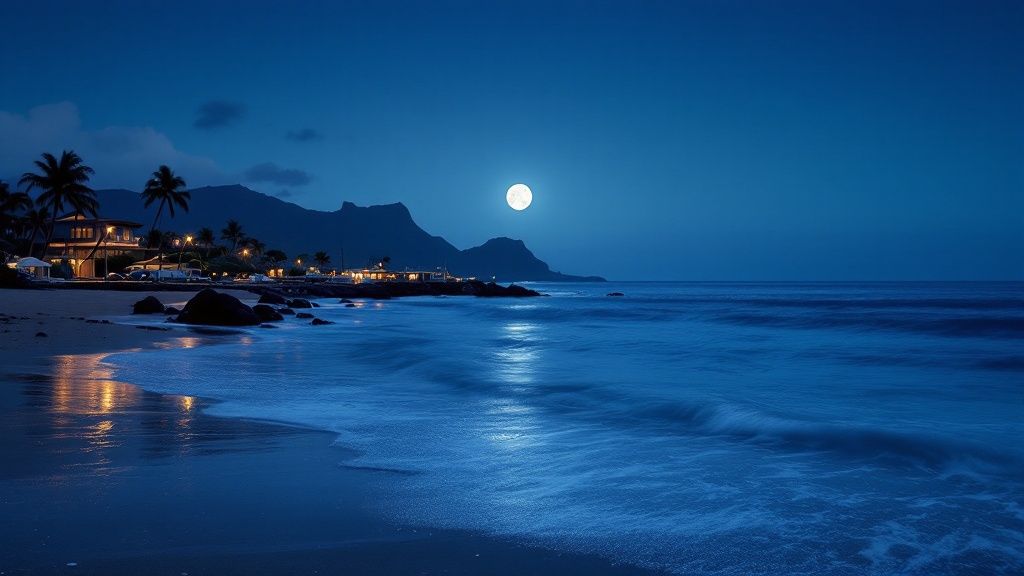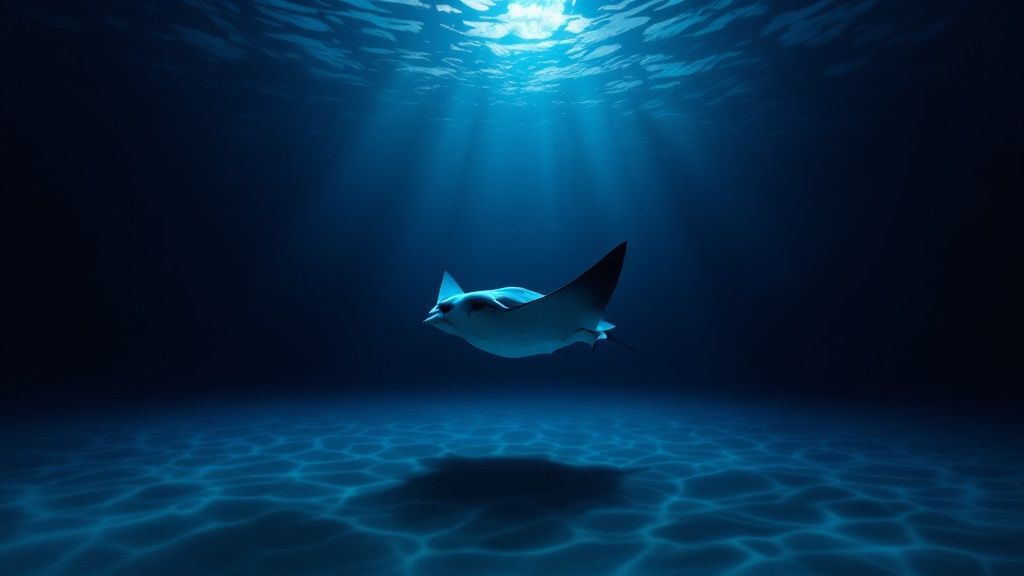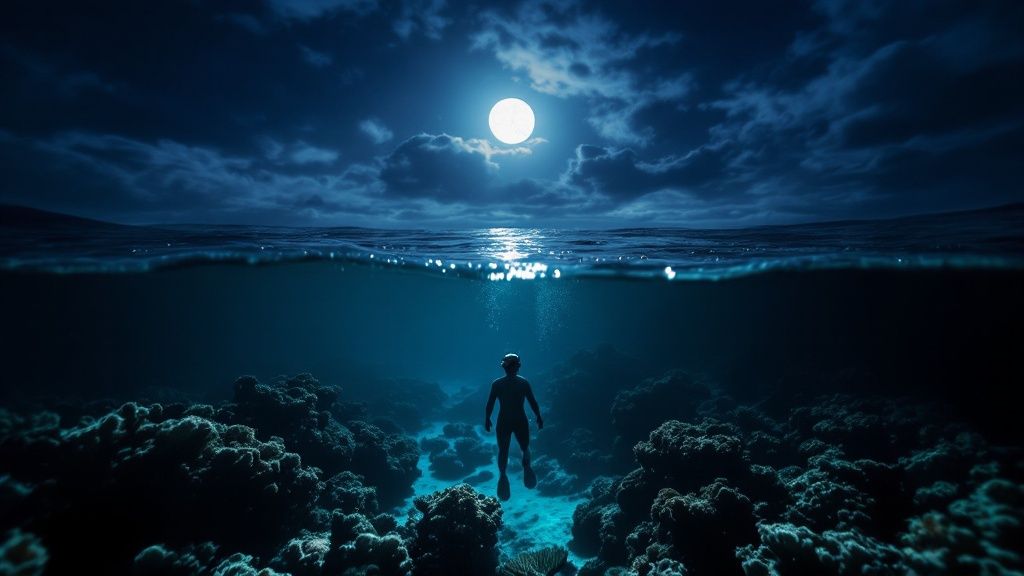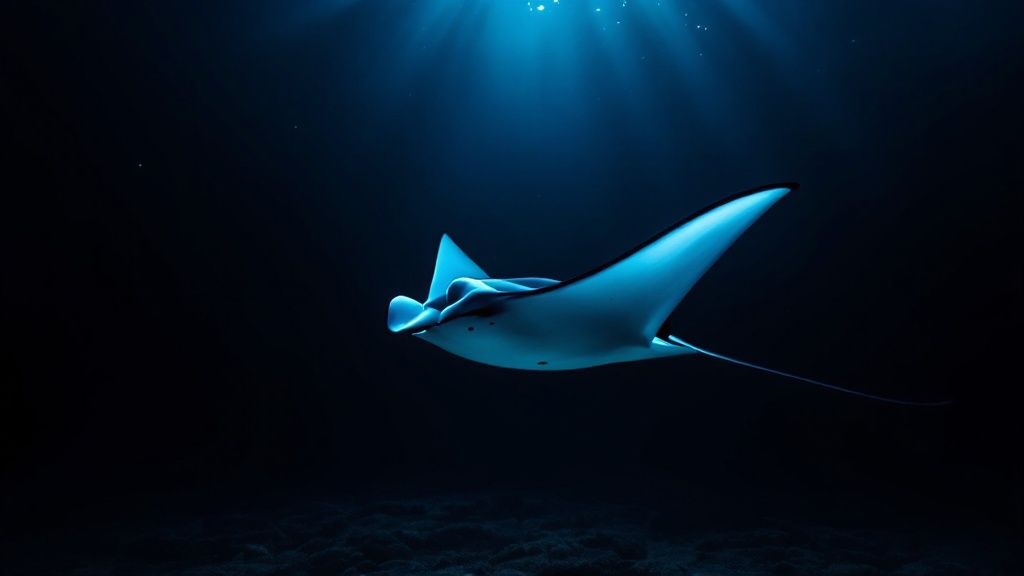Night Manta Ray Snorkel Kona: The Ultimate Experience Guide
- Byron
- Mar 15
- 11 min read
Why Kona's Night Manta Ray Experience Stands Alone

The Kona night manta ray snorkel isn't just another item to check off your bucket list; it's a truly unique encounter. This experience stands out because of the perfect combination of factors that create an ideal environment for both the manta rays and the snorkelers. Kona's volcanic slopes create deep, nutrient-rich waters. These waters attract large amounts of plankton, which is the manta ray's primary food source.
This abundance of food, combined with the typically clear, calm waters of the Kona coast, provides amazing viewing opportunities. You're practically guaranteed an unforgettable show. Specialized underwater lights enhance the experience even further.
These lights aren't just for illuminating the mantas. They attract plankton to the surface, which in turn draws the manta rays closer to the snorkelers. This allows for incredible, up-close views of these gentle giants as they perform their graceful feeding rituals. This carefully orchestrated interaction offers a unique opportunity to observe the manta rays while minimizing disruption to their natural habitat. The night manta ray snorkel in Kona attracts thousands of visitors annually. This unique encounter allows snorkelers to observe manta rays feeding on plankton, often performing spectacular barrel rolls just below the surface. Learn more about this incredible experience.
The success rate of spotting manta rays in Kona is remarkably high, between 80 and 90%. The underwater lights enhance the viewing experience by attracting plankton, drawing the manta rays closer. This phenomenon is especially notable at Manta Ray Village, where natural conditions and guided tours create an unforgettable experience.
The Role of Expert Guides
Experienced and knowledgeable guides further elevate the Kona night manta ray experience. These guides aren't just there for safety. They are passionate educators, eager to share their expertise about manta ray behavior, biology, and conservation.
For example, they can identify individual mantas by their unique spot patterns and share insights into their life histories. This adds another layer of depth and meaning to your encounter, transforming a simple snorkel trip into a deeper appreciation for these magnificent creatures.
The Magic of Manta Village
Kona boasts several excellent viewing locations. However, Manta Village in Keauhou Bay deserves special recognition. This location offers a particularly reliable and enriching experience.
The shallow, sheltered bay provides a natural gathering place for manta rays, increasing your chances of a close encounter. The consistent presence of mantas in this area, along with the expert guidance from local tour operators, makes for truly unforgettable moments. This dedication to responsible and sustainable tourism helps ensure future generations can also experience the magic of Kona's night manta rays.
Unforgettable Moments
The Kona night manta ray experience is truly unique because it combines all the right elements for a transformative encounter with nature: abundant plankton, clear waters, specialized lighting, and expert guides. This creates an unforgettable experience that can't be found anywhere else. The opportunity to witness these graceful giants in their natural habitat leaves a lasting impression on everyone.
Selecting Your Perfect Manta Ray Encounter

Not all Kona manta ray night snorkel tours are the same. Picking the right tour operator can make all the difference in creating a truly memorable experience. This involves understanding the various factors that contribute to a magical encounter. Some tours cater to smaller groups, creating a more intimate experience, while others accommodate larger groups on bigger boats.
Boat Design and Group Size
Larger boats might offer more amenities, but they can also feel crowded. Smaller boats, conversely, provide a more intimate setting and allow for more personalized attention from the guides. Smaller groups translate to less competition for the best viewing spots and more chances to connect with your guide. This is especially beneficial for first-time snorkelers or those who simply prefer a more personalized experience.
Lighting Techniques and Guide Expertise
The lighting used and the guide's knowledge are also key factors. Some operators use special blue lights known to attract plankton, the manta rays' main food source. Experienced guides can explain manta ray behavior, identify individual mantas by their markings, and share fascinating details about these gentle giants. This added educational element transforms a simple snorkel trip into a rich learning experience.
Departure Points and Safety Protocols
Where your tour departs from also plays a role in the overall experience. Kona has several manta ray viewing locations, each with its own distinct characteristics. Manta Village in Keauhou Bay is popular but can get crowded. Other locations may be further from shore, offering a potentially more tranquil experience. Choosing your departure point depends on whether you prioritize a shorter boat ride or a less crowded viewing area. Finally, researching the safety protocols of various operators is essential. Choose an operator with certified lifeguards, thorough safety briefings, and clear emergency procedures.
Comfort and Budget Considerations
Some tours offer added comforts, such as wetsuits, flotation devices, and hot drinks after your snorkel. These can greatly enhance your comfort, especially if you tend to get cold easily. However, these extras often come with a higher price tag. Consider which amenities are important to you and balance those against your budget. Smaller, boutique operators may offer more personalized service, while larger companies tend to be more budget-friendly. Carefully weigh your priorities to make the best decision.
To help you compare different tour options, we've put together a handy table summarizing key features:
Kona Manta Ray Tour Comparison: A detailed comparison of different manta ray snorkel tour options in Kona to help readers make informed decisions
Tour Type | Group Size | Price Range | Duration | Amenities | Best For |
|---|---|---|---|---|---|
Small Group Tour | 6-12 people | $150-$200 | 2-3 hours | Wetsuits, hot drinks, personalized attention | Those seeking a more intimate and personalized experience |
Large Group Tour | 20-40 people | $100-$150 | 2-3 hours | Basic snorkel gear | Budget-conscious travelers and those comfortable in larger groups |
Private Charter | Customizable | $500-$1000+ | Flexible | Customizable amenities, personalized itinerary | Families, groups, and those seeking ultimate flexibility and privacy |
This table highlights the various options available, from smaller, more intimate tours to larger, budget-friendly options and even private charters. Choosing the right tour depends on your personal preferences and budget.
Selecting the right manta ray night snorkel Kona adventure involves balancing what matters most to you – group size, guide experience, location, and budget. By weighing these factors, you can ensure an unforgettable experience.
Preparing for Manta Magic: Essential Know-How

Getting ready for your Kona manta ray night snorkel adventure should be filled with excitement, not pre-trip jitters. Understanding what awaits and planning accordingly is crucial. Just like seasoned guides advise, a little preparation can transform your experience. These insights will help you maximize your comfort and enjoyment during this amazing encounter.
Addressing First-Timer Concerns
Many first-time snorkelers experience anxiety about swimming at night. However, reputable tour operators like Manta Ray Night Snorkel prioritize safety and provide detailed briefings to ease these concerns. They provide flotation devices, such as pool noodles, allowing you to relax and conserve energy. Guides also address seasickness, recommending preventative measures like motion sickness medication before departure. This proactive approach helps ensure everyone has a positive experience.
Tips From the Pros
Experienced guides offer invaluable advice. They emphasize the importance of conserving energy in ocean currents by using provided flotation devices. They also suggest subtle positioning techniques to maximize your manta ray viewing. Staying close to the light boards that attract plankton, the manta rays' main food source, is one such tip. These small adjustments can significantly improve your experience.
Maximizing Your Experience
A few simple preparations can dramatically enhance your adventure. Pre-tour hydration is essential, as is a light, easily digestible snack. This helps prevent dehydration and seasickness. Familiarizing yourself with your underwater camera settings beforehand lets you capture stunning photos without struggling with your equipment in the water.
Gear Essentials for Every Season
Understanding appropriate gear for different seasons is key. During summer, a swimsuit might be enough. However, in winter, a wetsuit is highly recommended for warmth. Some operators provide wetsuits, so check in advance. This ensures you're prepared for any weather and can fully enjoy your experience.
Specific Considerations
Families with children, less-confident swimmers, and photography enthusiasts benefit from specialized preparation. Families should choose tours designed for younger participants, often featuring smaller groups and shorter times. Less-confident swimmers should communicate their concerns to the guides and utilize the provided flotation devices. Photography enthusiasts should have appropriate underwater camera equipment and be familiar with ideal settings for low-light conditions. With these considerations, everyone can enjoy a magical and memorable manta ray night snorkel experience in Kona.
Beyond Tourism: How Manta Encounters Fuel Kona's Economy

The Kona night manta ray snorkel experience offers more than just a thrilling encounter. It's become a vital part of the local economy, bringing positive change to the Kona community. From revitalizing coastal areas to creating new job opportunities, the manta rays have made a significant impact.
Economic Ripple Effects of Manta Tourism
Manta ray tourism has breathed new life into Kona's economy. The industry supports a wide range of businesses, from tour operators and dive shops to local restaurants and hotels. This influx of tourism dollars creates jobs and stimulates economic growth throughout the region. Previously struggling fishing villages, for example, have found new prosperity through manta ray tours, offering alternative income sources for residents.
More detailed statistics can be found here: Manta Ray Snorkel Kona: Epic Night Tour. An estimated 80,000 people participate in manta ray snorkeling or diving annually, contributing to a flourishing tourism industry. This activity supports local businesses and builds a sense of community among participants and guides. The tours' popularity has led to diverse options, from sunset snorkels to specialized underwater photography services, catering to various interests.
Specialized Career Paths
Manta ray tourism has also created specialized career opportunities. Marine science graduates can now find work as guides, researchers, and conservationists, directly applying their knowledge and passion. This creates a positive feedback loop: tourism supports scientific research, which in turn improves the quality and sustainability of the manta ray encounters.
Funding for Conservation Efforts
Revenue generated by Kona night manta ray tours isn't just boosting the local economy; it's directly funding crucial habitat protection. Tour operators often collaborate with conservation organizations, donating a portion of their profits to research and preservation projects. This means that by taking a manta ray tour, visitors directly contribute to the long-term survival of these amazing creatures and their ecosystem.
Community-Business Partnerships: A Win-Win for All
Innovative partnerships between local businesses and the community further enhance the positive effects of manta ray tourism. These collaborations ensure that tourism revenue directly benefits residents. Some operators fund educational programs for Hawaiian students, promoting a deeper understanding of marine life and conservation. Others invest in infrastructure improvements, benefiting both visitors and residents. These joint efforts create a sustainable tourism model where economic growth and environmental protection work together, ensuring the magic of the Kona night manta ray snorkel experience remains for generations to come.
Conservation in Action: The Ethics of Manta Encounters
The breathtaking experience of a night manta ray snorkel in Kona isn't just a spectacle; it's an integral part of the complex relationship between tourism and conservation. This industry has evolved from largely unregulated beginnings to a model of responsible wildlife tourism. Understanding this transformation reveals the significant power of sustainable practices.
From Unregulated to Responsible: A Shift in Mindset
Initially, manta ray encounters were largely unregulated. However, a growing awareness of the potential environmental impact of tourism created a shift toward more responsible practices. Research, for example, highlighted the importance of minimizing disturbances to manta rays during their feeding. This new awareness spurred the development of crucial guidelines and best practices for tour operators.
Funding Conservation Through Tourism: A Symbiotic Relationship
Today, visitor fees from night manta ray snorkel Kona tours often directly fund vital research projects and habitat protection initiatives. This financial support creates a truly symbiotic relationship: the tourism industry supports the very conservation efforts that protect the animals it relies on. This means that by choosing a reputable tour operator, your money directly contributes to the well-being of these gentle giants.
Identifying Truly Responsible Operators: Beyond Greenwashing
It's crucial to distinguish between truly responsible operators and those simply employing "greenwashing" in their marketing. Look for specific behaviors and practices that demonstrate genuine commitment. Responsible operators adhere to strict guidelines regarding boat proximity to the mantas, limit group sizes, and educate guests about manta ray biology and conservation. They actively participate in research initiatives and contribute to local conservation efforts. Furthermore, responsible guides emphasize the importance of not touching the mantas, as their delicate mucous layer is essential for their health.
Citizen Science: Your Role in Manta Conservation
Many night manta ray snorkel Kona tours offer exciting citizen science opportunities. This means your observations during the tour can contribute directly to scientific research. You might be asked, for instance, to help identify individual mantas based on their unique spot patterns. This valuable data helps researchers track manta ray populations and better understand their complex behaviors. This active involvement transforms your experience from passive observation to active participation in vital conservation efforts.
The Impact of Your Choices: A Collective Responsibility
Ultimately, the future of these magnificent creatures depends on our collective choices. By supporting responsible tour operators, participating in citizen science initiatives, and practicing environmentally conscious behavior, we can help ensure future generations have the opportunity to experience the magic of night manta ray encounters in Kona. Every choice, from the tour operator you select to your actions in the water, has a direct impact on the long-term health of the manta ray population and the delicate ecosystem they inhabit. This shared responsibility underscores the importance of informed decision-making when planning your night manta ray snorkel Kona adventure.
The Remarkable Story of Kona's Manta Population
The mesmerizing dance of manta rays under Kona's night waters is more than just a beautiful show. It's a window into a complex and fascinating evolutionary tale. These gentle giants, some with wingspans reaching over 10 feet, possess surprising intelligence, unique personalities, and intricate social behaviors. These factors contribute to the profound experience of each night manta ray snorkel Kona adventure.
Identifying and Tracking Kona's Mantas
Every manta ray has a unique spot pattern on its underside, similar to a human fingerprint. Researchers and guides use these patterns to identify individual mantas, giving them names and tracking them over their decades-long lives. This careful tracking has uncovered fascinating insights into their life histories, migration patterns, and social structures.
Some mantas, for example, show strong site fidelity, returning to the same feeding areas year after year. Others are more nomadic in their habits.
Celebrity Mantas and Groundbreaking Discoveries
Certain charismatic individuals, like the aptly named "Big Bertha," have become celebrities among guides and researchers. Their frequent appearances and distinct personalities make them favorites among night manta ray snorkel Kona enthusiasts. By observing these individuals and the Kona manta population, researchers are making groundbreaking discoveries. These include previously unknown feeding strategies, communication methods, and mating behaviors. Check out our blog post sitemap for related articles.
Climate Change and Innovative Monitoring Techniques
The Kona coast has long been a hub for marine research and exploration. While specific historical data on manta ray snorkeling is limited, the area's unique ecosystem has drawn scientific interest for decades. The combination of natural conditions and the presence of manta rays has made Kona a prime location for studying these creatures in their natural environment. Over time, this has blossomed into a thriving tourist activity, with manta ray snorkeling becoming one of Hawaii's most popular experiences. Explore this topic further.
However, these magnificent creatures face increasing threats, including the effects of climate change. Changes in ocean temperature and acidity can impact plankton populations, the manta rays' primary food source. This can disrupt their feeding patterns and overall health.
Fortunately, innovative monitoring techniques, like satellite tagging and aerial surveys, provide essential data for global manta conservation efforts. This information helps researchers understand how climate change affects manta ray populations and develop strategies for their protection.
To illustrate some key characteristics of the manta rays found in Kona, take a look at the following table:
Kona Manta Ray Statistics
Key facts and figures about manta rays in Kona waters, including population data, size ranges, and behavior patterns.
Characteristic | Data Point | Significance |
|---|---|---|
Wingspan | Up to 18 feet | Demonstrates their impressive size and maneuverability |
Diet | Plankton | Highlights their role in the ecosystem as filter feeders |
Lifespan | Estimated 40+ years | Underscores the importance of long-term conservation efforts |
Social Behavior | Often seen in groups | Suggests complex social structures and communication |
Spot Patterns | Unique to each individual | Enables researchers to track and identify specific mantas |
This table summarizes some of the remarkable features of these gentle giants, emphasizing their size, role in the ecosystem, and the importance of ongoing research.
Experience the Magic of Kona's Manta Rays
Ready to experience the wonder of Kona's manta rays yourself? Book your unforgettable night manta ray snorkel Kona adventure with Manta Ray Night Snorkel Kona Hawaii Tours today! We offer intimate, small-group tours led by expert guides passionate about sharing the magic of these gentle giants while prioritizing their well-being. Book your tour now and create memories that will last a lifetime.
Comentários